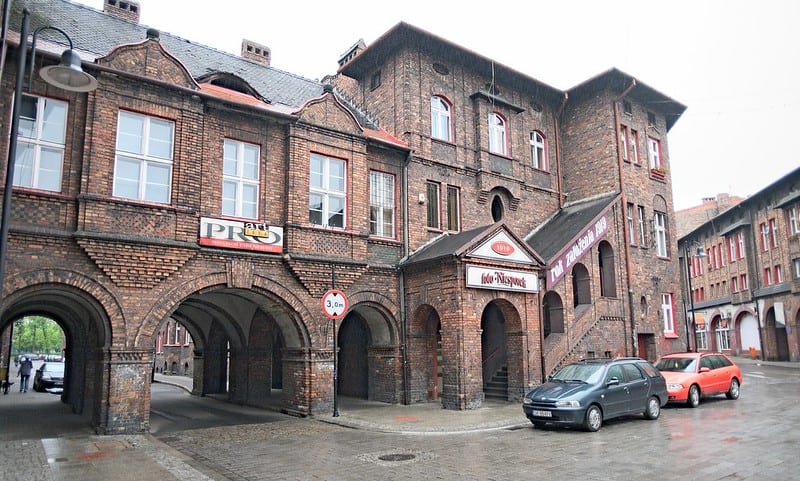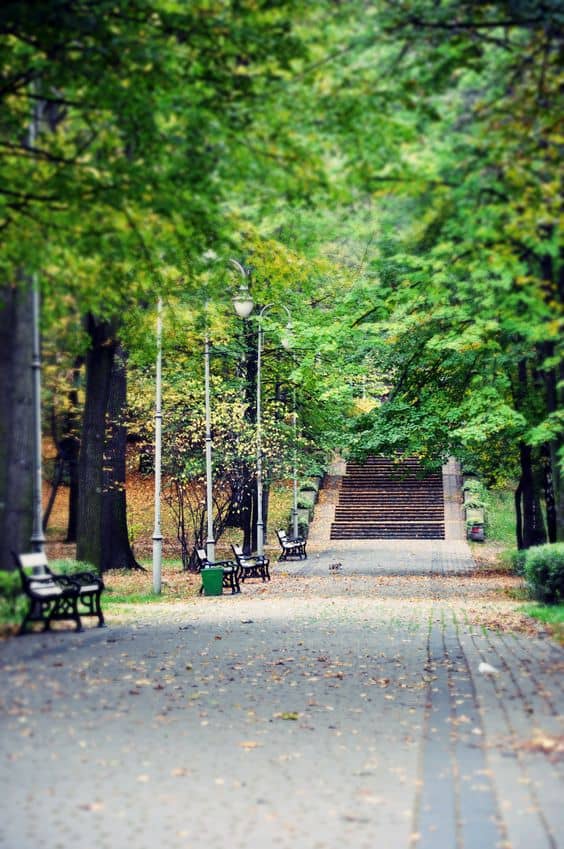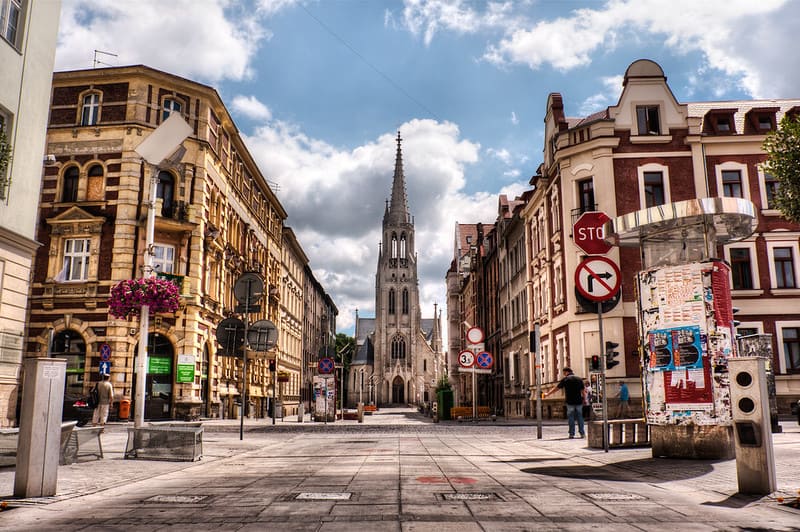Katowice is the capital of the Silesian Voivodeship in southern Poland. It is the centre of the Upper Silesian metropolitan area and is the 11th most populous city in Poland. Its urban area is the largest in Poland and the European Union. Visitors can explore Katowice’s numerous attractions and enjoy the city’s rich history.
History of Katowice Poland
Situated in the heart of the Silesian region, Katowice is a city with a history that weaves together tales of industrial development, cultural heritage, and resilience. From its humble beginnings as a small village to its emergence as a bustling metropolis, Katowice’s journey through time is a captivating story of transformation. Let’s take a historical voyage through Katowice’s past with a timeline of significant events.
Pre-19th Century:
- 14th Century: Katowice’s history can be traced back to the 14th century when it was a small village under the rule of the Duchy of Silesia.
- 16th – 18th Century: The village of Katowice experienced slow growth, with agriculture and iron mining being the primary economic activities.
19th Century:
- 1823: The construction of the Warsaw-Vienna railway line led to the expansion of Katowice as a significant transportation hub.
- 1865: The city was granted municipal rights, marking the beginning of its transition from a rural settlement to an urban center.
20th Century:
- 1919: After Poland regained independence, Katowice became a part of the newly established Second Polish Republic.
- 1922: The Silesian Uprisings took place, reflecting the region’s struggle for autonomy and Polish identity.
- 1926: Katowice officially became the capital of the Silesian Voivodeship, solidifying its political and administrative significance.
- 1939 – 1945: During World War II, Katowice fell under German occupation, and the city witnessed significant destruction. After the war, it was reintegrated into Poland.
- 1950s – 1980s: Katowice played a crucial role in the industrialisation of Poland, with the establishment of numerous heavy industries, including coal mining and steel production.
21st Century:
- 2007: The Silesian Museum was opened, celebrating the region’s rich history and culture.
- 2015: Katowice hosted the United Nations Climate Change Conference (COP24), a significant event that brought global attention to the city’s commitment to sustainability and environmental issues.
Over the years, Katowice has evolved from a small village into a dynamic city that embraces its historical roots while embracing modernity. Today, it stands as a vibrant cultural and economic hub, where industrial heritage meets contemporary art and innovation. Katowice’s rich tapestry of history continues to unfold, leaving a lasting legacy that showcases the resilience and spirit of its people.
Silesian Museum
The Silesian Museum (Polish: Muzeum Śląskie) is a cultural institution located in Katowice, Poland. It was established in 1929 and is dedicated to the history, culture, and art of the Silesian region, which is located in southern Poland.
The museum has a collection of more than 400,000 objects, including works of art, artifacts, and documents related to the history of the Silesian region. The collection includes items from the pre-historic period to the present day, and covers a wide range of subjects, including art, archaeology, history, natural history, and ethnography.
The museum has several permanent exhibitions, including the Gallery of Silesian Art, which features works by artists from the region, and the Gallery of Silesian Ethnography, which displays traditional folk costumes, crafts, and other cultural artifacts from the Silesian region.
In addition to its permanent exhibitions, the museum also hosts temporary exhibitions and cultural events, such as concerts, lectures, and workshops.
The Silesian Museum is located in the heart of Katowice, in a building designed by architect Wacław Hryniewicz. It is a popular tourist attraction and an important cultural institution in the region.
Nikiszowiec

When you are visiting Katowice, don’t miss the nearby Nikiszowiec Museum. This fascinating museum, located in a planned industrial district from the 1910s, houses a wide variety of exhibits. The exhibits showcase everyday life in Katowice, from the 1200s to the present. There are also special collections dedicated to famous locals.
You can take a free audio tour of this historic building at Rymarka 4 in Nikiszowiec. To rent an audio tour, you must show a valid photo ID. You can also visit the museum’s Industrial Ethnographic Museum.

Valley of Three Ponds
The Valley of Three Ponds is a large park located in the southern part of the city. With green grass and blue water, it is a great place for a picnic. The area is also well connected by public transport. This is a great place for children and families to have fun.
The valley is surrounded by beautiful trees and the surrounding area is a recreational park, which includes canoeing, hiking, and biking trails. The park is also home to various concerts and events. If you’re visiting Katowice, be sure to visit the Valley of Three Ponds.
Guitar History Museum
The Guitar History Museum in Katowice Poland is a privately-owned museum with displays of historical instruments and information about the guitar. Tours are available by appointment. The museum is open from October to June, and admission is free. It is worth a visit if you are a guitar lover.
The museum features a collection of over 200 guitars from all over the world. Its mission is to provide education about the history of the guitar, as well as the evolution of the instrument. It also provides guided tours, and visitors can try out the guitars. This is one of the most interesting things to do in Katowice.
The city has many historical sights and is home to the famous Katowice Cathedral. The Silesian Parliament is another impressive building, and the Silesian Philharmonic is home to live performances. The Guitar History Museum, in the city center, provides a historical overview of the guitar and invites visitors to play a guitar. If you are traveling by plane, Katowice Airport is located 19 miles north of the city center. You can take transient and empty-leg flights to get to Katowice.
Kosciuszko Park
The Parachute tower in Kosciuszko Park in the city of Katowice is a landmark and a symbol of the city. It was constructed in 1937 at the initiative of the League and was constructed with the purpose of making the city Air Defence-proof. It was later demolished by German authorities. Its current design is only 35 meters tall, but its original steel frame was 50 meters high. It was also equipped with a lift shaft. It had a double electric lift.
The park is a popular spot for outdoor recreation. It has a toboggan run and is the city’s largest park. Many locals use the park for walks or bike rides. It is also home to a city bike station and toboggan runs.
The park is also home to a permanent gallery of plein-air sculptures by famous regional artists. Here, you can see works by artists such as Augustyn Dyrda, Zygmunt Brachmanski, Piotr Latoska, Jacek Sarapata, and Andrej Szczepaniec.

Museum of the History of Katowice
The Museum of the History of Katowice Poland is a multi-story, four-story building with an Art Nouveau exterior. The building was originally constructed for wealthy citizens of Katowice in 1908. The interiors are filled with original furniture and decorations, and a permanent exhibition recreates the interiors of middle-class households from the early 20th century.
The museum also displays artifacts from the city’s past, ranging from medieval times to the present. The exhibits cover topics from the city’s rural beginnings to its industrial development, and use multimedia to tell the story of the city through the ages. The museum is open to the public and is well worth the visit.
The Museum of the History of Katowice has a variety of permanent and temporary exhibitions. Visitors can enjoy a variety of art works in the Pawel Steller department, which is named after a famous graphic artist who lived for almost 50 years in the city. Pawel Steller was nicknamed the “Polish Durer” by Western critics, and the museum is home to one of the largest collections of Steller’s works. The Pawel Steller department also features a permanent exhibition of wood engravings.
Mariacka Street
The weather in Katowice can be extremely cold in March, and the city is often referred to as having “bowler hat weather” by Poles. It can reach over 20 degrees S in the afternoon and drop to -20 degrees S in the evening. The first day of real spring in Katowice is March 23rd.
If you love architecture, you’ll want to see the Cathedral of Christ the King. This neo-classical masterpiece is the largest church in Poland and features a beautiful dome. Its interiors feature numerous stained-glass windows and a unique wheel crucifix. Nearby, you can also see the Archdiocesan Museum, which has exhibits of sacred art from past centuries.
The main high street of Katowice is Mariacka Street, which is less than five minutes walk from the Rynek. Mariacka serves as the heart of the city, and the central strip of bars and restaurants draws visitors from all over the city. During the day, the street is relatively quiet and clean, but at night, it becomes a hotspot for partygoers and those who want to feel the city pulse. In summer, the street is lined with beer gardens, which make the streets a pleasant place to enjoy an afternoon or evening.
Market Square
The Market Square in Katowice, Poland is the central feature of Srodmiescie district, and dates back to the late 19th century. Over the years, it has undergone a number of transformations. The original Market Square had an asphalt floor, a tram stop, and flower stands. The Square is currently being redeveloped.
Today, this historic market square houses a tourist information center and a Silesian Theatre. The square’s top tenement houses have a bugle call that you can hear from the top of one of them. It was originally known as Marktplatz. When you’re in the area, take a few minutes to walk around the town square, and you’ll be able to experience the local way of life.
If you’d like to shop for Polish products, Katowice has plenty of options for you. There are two large malls nearby, with several shopping centers and restaurants. The nearby Mariacka Street is also worth walking down for a look. You can also take a look at the Glowny Square, which has many cultural and historic exhibits.
Best Places to Eat in Katowice Poland
Nestled in the heart of Poland’s Silesian region, Katowice is not only known for its industrial heritage and vibrant cultural scene but also for its rich culinary offerings. The city’s diverse food scene reflects its multicultural history and a blend of traditional Polish flavors with contemporary influences. Whether you are a food enthusiast or a curious traveler, here is a gastronomic journey through the best places to eat in Katowice.
1. Gospoda u Wrochema: Delight in authentic Polish cuisine at Gospoda u Wrochema, a charming restaurant known for its warm ambiance and traditional dishes. Savor the taste of hearty pierogis, tender Polish sausages, and flavorful bigos (hunter’s stew) while immersing yourself in a cozy, rustic setting.
2. Śląska Prohibicja: Located in the heart of Katowice, Śląska Prohibicja offers a unique dining experience with its carefully crafted Silesian menu. Indulge in regional specialties such as kluski śląskie (Silesian dumplings) and rolada (stuffed beef roll) while enjoying the friendly atmosphere of this family-run eatery.
3. Ristorante il Pozzo: Craving Italian cuisine in Katowice? Look no further than Ristorante il Pozzo. This beloved Italian restaurant serves up delectable pasta dishes, wood-fired pizzas, and mouthwatering seafood, transporting diners to the streets of Italy with every bite.
4. Tabasco Bar & Grill: For meat lovers, Tabasco Bar & Grill is a must-visit destination. This trendy steakhouse offers a wide selection of succulent grilled meats, complemented by an array of flavorful sauces and side dishes, making it a carnivore’s paradise.
5. Pimiento: Embark on a culinary journey to Argentina at Pimiento, an Argentine steakhouse in Katowice. Indulge in premium cuts of beef cooked to perfection on the open grill, while sipping on fine Argentine wines that beautifully complement the meal.
6. Pikanteria Vegan & Vegetarian Bistro: Vegetarian and vegan enthusiasts will find solace at Pikanteria, where innovative plant-based dishes take center stage. From colorful buddha bowls to flavorful vegan burgers, this bistro caters to all dietary preferences without compromising on taste.
7. Pod Aniołem: Housed in a charming historic building, Pod Aniołem is a culinary gem offering a fusion of Polish and European flavors. With an emphasis on locally sourced ingredients, the restaurant presents an ever-changing menu that celebrates seasonal produce.
8. Niko Sushi: Satisfy your sushi cravings at Niko Sushi, an authentic Japanese eatery that delivers the finest sushi and sashimi. Indulge in artfully prepared rolls and fresh seafood, served in an inviting and contemporary setting.
9. Sznyk Bistro: Sznyk Bistro is a trendy spot that combines traditional Polish cuisine with modern twists. With a focus on seasonal ingredients and creative presentations, every dish here is a feast for the senses.
10. Browar Zamkowy: End your culinary journey with a visit to Browar Zamkowy, a charming microbrewery and restaurant located in a historic building. Sample a selection of craft beers brewed on-site, paired with delicious pub-style fare.
Katowice’s vibrant culinary scene invites you to embark on a delectable adventure, where every bite reflects the city’s diverse heritage and innovation. From traditional Polish delicacies to international flavors, the best places to eat in Katowice promise a gastronomic experience that will leave you craving more.
Best Places to Stay in Katowice Poland
- Hotel Monopol: This five-star hotel is housed in a historic building and offers luxurious rooms, elegant decor, and top-notch amenities. It’s centrally located, making it a great choice for exploring the city’s attractions.
- Courtyard by Marriott Katowice City Center: Situated in the heart of the city, this modern hotel offers comfortable rooms, a fitness center, and a rooftop terrace with panoramic views of Katowice.
- Vienna House Easy Katowice: This stylish hotel features contemporary design and is located near the Spodek arena and Silesia City Center mall. It’s a convenient choice for both business and leisure travelers.
- B&B Hotel Katowice Centrum: This budget-friendly hotel offers clean and comfortable rooms in a central location, making it an excellent choice for travelers seeking affordable accommodation.
- Novotel Katowice Centrum: This family-friendly hotel offers spacious rooms, a fitness center, and a play area for children. It’s located near the city center and the main railway station.
- Angelo by Vienna House Katowice: With its modern design and artistic flair, this hotel offers a unique stay experience. It’s located close to the Spodek arena and the Silesian Museum.
- EuroResidence Apartament Home: If you prefer the comfort of an apartment-style accommodation, this hotel provides fully equipped apartments with kitchenettes, suitable for extended stays.
- Hotel Diament Plaza Katowice: This four-star hotel offers comfortable rooms and a restaurant serving Polish and international cuisine. It’s situated within walking distance of the city center and various attractions.
- Park Inn by Radisson Katowice: Located near the International Congress Center, this hotel offers modern rooms, a fitness center, and a rooftop terrace with city views.
- Rezydent Silesia: This boutique hotel features a blend of historic charm and contemporary design. It’s located in the Nikiszowiec district, known for its unique architecture and cultural significance.
10 interesting facts about Katowice
- Katowice is the largest city in the Silesian region of Poland, with a population of over 300,000 people.
- The city was founded in the early 19th century, and was originally a small settlement known as “Katowice” (meaning “furnace” in Polish) because of its many coal mines and steel mills.
- Katowice is known for its rich cultural heritage, with many museums, galleries, and theaters located in the city.
- The city is also home to the University of Silesia, one of the oldest and most prestigious universities in Poland.
- In recent years, Katowice has undergone a major transformation, with the city centre undergoing extensive redevelopment and revitalization.
- The city is now known for its vibrant nightlife and diverse culinary scene, with many restaurants, bars, and cafes to choose from.
- Katowice is also an important hub for business and commerce, with many major companies based in the city.
- In 2018, the city played host to the United Nations Climate Change Conference, known as COP24, which was attended by over 25,000 delegates from around the world.
- Katowice is also home to the Silesian Museum, one of the largest and most important museums in Poland, which showcases the history and culture of the Silesian region.
- The city is located in southern Poland, near the border with the Czech Republic and Slovakia, and is easily accessible by train, bus, or car from other major cities in the region.

